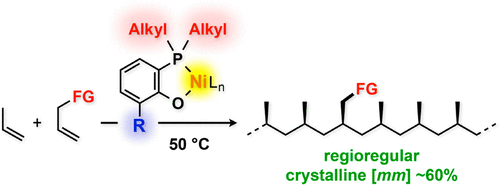当前位置:
X-MOL 学术
›
ACS Macro Lett.
›
论文详情
Our official English website, www.x-mol.net, welcomes your
feedback! (Note: you will need to create a separate account there.)
Nickel-Catalyzed Propylene/Polar Monomer Copolymerization
ACS Macro Letters ( IF 5.1 ) Pub Date : 2018-01-30 00:00:00 , DOI: 10.1021/acsmacrolett.7b00904 Yohei Konishi 1 , Wen-Jie Tao 2 , Hina Yasuda 2 , Shingo Ito 2 , Yasuo Oishi 1 , Hisashi Ohtaki 1 , Akio Tanna 3 , Takao Tayano 3 , Kyoko Nozaki 2
ACS Macro Letters ( IF 5.1 ) Pub Date : 2018-01-30 00:00:00 , DOI: 10.1021/acsmacrolett.7b00904 Yohei Konishi 1 , Wen-Jie Tao 2 , Hina Yasuda 2 , Shingo Ito 2 , Yasuo Oishi 1 , Hisashi Ohtaki 1 , Akio Tanna 3 , Takao Tayano 3 , Kyoko Nozaki 2
Affiliation

|
Nickel complexes bearing bidentate alkylphophine–phenolate ligands were synthesized and applied to the polymerization of propylene and the copolymerization of propylene and polar monomers. Therein, the use of bulky alkyl substituents on the phosphorus atom was crucial for the formation of highly regioregular polypropylenes. Theoretical calculations suggested that the 1,2-insertion of propylene is favored over the 2,1-insertion in these nickel-catalyzed (co)polymerization reactions. The substituent at the ortho position relative to the oxido group greatly influences the polymerization activity, the molecular weight, and stereoregularity of the polypropylenes. This method delivers moderately isotactic ([mm] ≤ 68%) crystalline polypropylenes. The present system represents the first example for a nickel-catalyzed regiocontrolled copolymerization of propylene and polar monomers such as but-3-en-1-ol, but-3-en-1-yl acetate, and tert-butyl allylcarbamate.
中文翻译:

镍催化丙烯/极性单体共聚
合成了带有二齿烷基膦-酚盐配体的镍络合物,并将其应用于丙烯的聚合以及丙烯与极性单体的共聚。其中,在磷原子上使用庞大的烷基取代基对于形成高度规整的聚丙烯至关重要。理论计算表明,在这些镍催化的(共)聚合反应中,丙烯的 1,2-插入优于 2,1-插入。相对于氧基的邻位取代基极大地影响聚丙烯的聚合活性、分子量和立构规整性。这种方法提供中等等规([毫米] ≤ 68%) 结晶聚丙烯。本系统代表了丙烯和极性单体如 3-烯-1-醇、乙酸丁-3-烯-1-酯和烯丙基氨基甲酸叔丁酯的镍催化区域控制共聚的第一个例子。
更新日期:2018-01-30
中文翻译:

镍催化丙烯/极性单体共聚
合成了带有二齿烷基膦-酚盐配体的镍络合物,并将其应用于丙烯的聚合以及丙烯与极性单体的共聚。其中,在磷原子上使用庞大的烷基取代基对于形成高度规整的聚丙烯至关重要。理论计算表明,在这些镍催化的(共)聚合反应中,丙烯的 1,2-插入优于 2,1-插入。相对于氧基的邻位取代基极大地影响聚丙烯的聚合活性、分子量和立构规整性。这种方法提供中等等规([毫米] ≤ 68%) 结晶聚丙烯。本系统代表了丙烯和极性单体如 3-烯-1-醇、乙酸丁-3-烯-1-酯和烯丙基氨基甲酸叔丁酯的镍催化区域控制共聚的第一个例子。











































 京公网安备 11010802027423号
京公网安备 11010802027423号